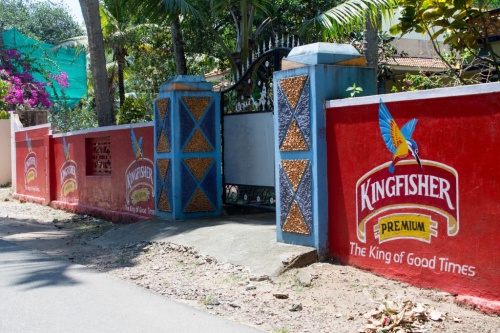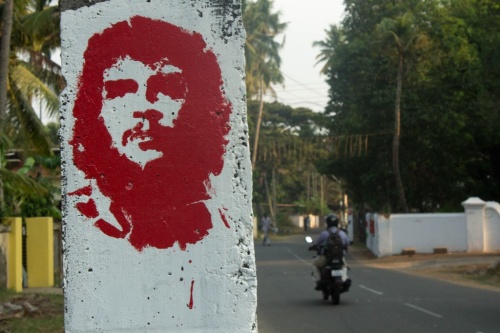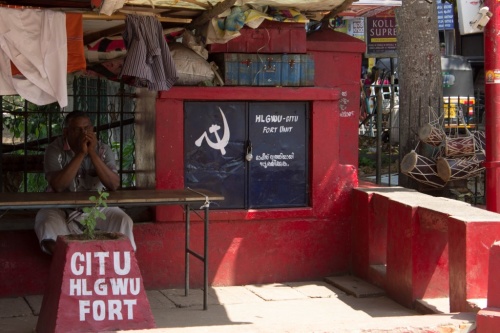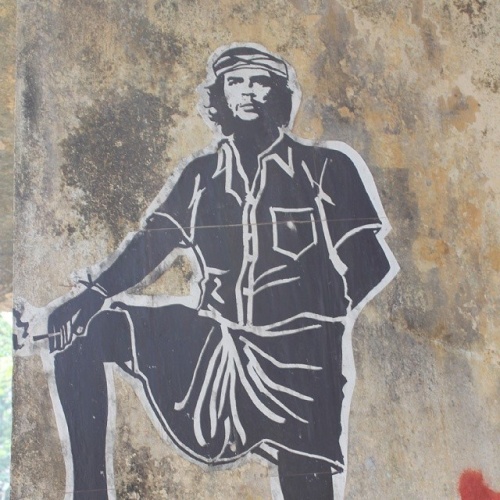9th April 2014
After I had made all my arrangements to go to Kerala, I found out something fantastic: it has an active communist party (or two)! Does communism find me or am I chasing communism? Either way, I find it fascinating, especially to see how it works in a unicameral parliamentary democracy. Kerala prides itself on being the first place where communism came into power via peaceful elections, a tidbit no one lost any time in telling me. TheCommunist Party of India (Marxist), which leads the Left Democratic Front (which includes the currently-impotent Communist Marxist Party), is still very active, generally winning elections on alternating 5 year terms.
The Kerala Land Reform Act (which originated in 1963 with several notable amendments), gave land rights to tenants, ending the feudal system (except for cash crops) and giving thousands a home of their own for the first time. The reform completely altered the state and set it on a trajectory for relatively little economic stratification. Redistribution of wealth (and land in particular) is a hallmark of communism, often lamented by wealthy landowners, and beloved by hardworking farmers freed of their peasant status (unless they’re just random people who you forced to be farmers. That doesn’t go over to well.) People commonly referred to Kerala as a state made entirely of the middle class, and I think the land reforms were a key factor in this.
Communism in Kerala hit a turning point in 1967 with the Naxalite uprising, and other ensuing violent acts. Elements within the party wanted a more anarchic stance, and used violence to that end, which drastically changed public opinion. The communists, who at the time were one party, were forced out of government and had to clean house. Naxalites and other destabilizing elements split from the party, and the purged CPI(M) returned to the national discourse, Naxalites are still active (and violent) in India, although deaths have decreased in the last few years.
Communism in Kerala hit a turning point in 1967 with the Naxalite uprising, and other ensuing violent acts. Elements within the party wanted a more anarchic stance, and used violence to that end, which drastically changed public opinion. The communists, who at the time were one party, were forced out of government and had to clean house. Naxalites and other destabilizing elements split from the party, and the purged CPI(M) returned to the national discourse, Naxalites are still active (and violent) in India, although deaths have decreased in the last few years.

An ad (or street art?) from the party that leads the other coalition in Kerala, the Indian National Congress
The acceptance of religion and ignoring class differences are major departures from classical communism. That did not go unnoticed. Eventually, the powers that be in Moscow and Beijing decided that Kerala communism wasn’t communist enough, and turned their backs. Honestly, from the standpoint of human rights, efficacy, corruption, and common sense, having communist leaders in China and the USSR say you don’t make the grade is a bit of a compliment.
Another manifestation of communism is the bureaucracy in Kerala, though to be honest I think that’s a hallmark of governance. The Nazis had bureaucracy and they were fascists, on the complete opposite political pole. Both liberal and conservative politicians in the US have put forth bills that embellish our already strong bureaucratic tradition. Basically, bureaucracy = government jobs, so it’s in the government’s best interest to keep itself (and its friends) in business. While several different Indians blamed the bureaucracy of Kerala on communism to me throughout the trip, I’m not sold. Convince me in the comments, guys!

Advertisements for Kingfisher, the most popular beer. While the beer itself isn’t nationalized, all alcohol sales in Kerala are public.
What did make me think of communism was the state-run liquor distribution. Obviously nationalizing industries is a hallmark of communism, but so is standing in lines for basically no reason. If it were a sport, people in communist countries would win the world cup of queueing every time, and their governments would be champions of creating high numbers of needless lines, usually in inconvenient locations. Stay tuned for a post on alcohol in Kerala because it’s fascinating there. And delicious. Just kidding, Indian wine was terrible, but the beer and whiskey were passable.
I think it’s interesting how many pockets of communism there really are left. The American view is that it’s all gone–except for our own president, of course. All kidding aside, people do seem incredulous that Sweden’s Third Way exists, or that Cuba is not actually a barren wasteland. Which leads many people to argue that all of this isn’t really communism. In some cases that’s true–Kerala isn’t a purely communist state, more like a liberal welfare state with an extra dose of paternalism and solidarnosc–but I’d also argue many capitalist countries aren’t purely capitalist anymore, including the US. And thank god for that–the Gilded Age was the worst.
Kerala certainly embodies an overall egalitarian quality, with stronger workers’ rights, high levels of education and healthcare, less prominent caste system (it’s still there though, more on that in a later post), overall religious tolerance, and a high sex ratio (that is, XX fetuses aren’t being selectively aborted as they are in much of the world, including other parts of India.) It is also quite developed compared to the rest of India, with the highest life expectancy, lowest homicide rate, and lowest corruption in the whole of India. Kerala also has a strong focus on environmentalism and recycling, which we saw in hotels and public campaigns everywhere we went in the state. Globally Kerala does quite well in regards to development, with an HDI of 0.79, which translates to “High Development” (the only Indian state to do so) compared to India as a whole, which scored 0.554, or “Medium Development”. (I cannot tell you how excited I was when our tour guide, Manoj, brought up the Human Development Index!) Basically, Kerala is my kind of communism: take away all the censorship (newspapers for days!), corruption, and human rights violations, and add religious tolerance and a high standard of living. Of course, do the same thing to capitalist countries and I’m all in as well.
These successes are not purely a credit to the CPI(M), but also to the United Democratic Front (the opposition, led by theIndian National Congress), the virtues of coalition governance, Kerala’s matrilineal history, the educational and cosmopolitan influences of outsiders, including the church, and the people of Kerala for voting for progressive parties and measures, and holding their government accountable. There’s certainly still a lot of work ahead of Kerala, especially in terms of sewage and water treatment, waste management, a high reliance on remittances, and lingering class and gender issues. It really depends on what you compare Kerala with, the rest of India, other parts of the Global South, or the Global North. Sewage, water treatment and remittances are major issues in the Global South, whereas waste management, class and gender issues need work worldwide.


